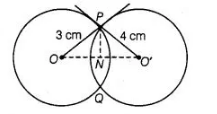Two circles with centres 0 and 0′ of radii 3 cm and 4 cm, respectively intersect at two points P and Q, such that OP and 0’P are tangents to the two
circles. Find the length of the common chord PQ.
Here, two circles are of radii OP = 3 cm and PO’ = 4 cm
These two circles intersect at P and Q.

Here, $O P$ and $P O^{\prime}$ are two tangents drawn at point $P$.
$\angle O P O^{\prime}=90^{\circ}$
[tangent at any point of circle is perpendicular to radius through the point of contact]
Join $O O^{\prime}$ and $P N$.
In right angled $\triangle O P O^{\prime}$,
$\left(O O^{\prime}\right)^{2}=(O P)^{2}+\left(P O^{\prime}\right)^{2}$ [by Pythagoras theorem]
i.e., $\quad(\text { Hypotenuse })^{2}=(\text { Base })^{2}+(\text { Perpendicular })^{2}$
$=(3)^{2}+(4)^{2}=25$
$O O^{\prime}=5 \mathrm{~cm}$
Aso, $P N \perp O O^{\prime}$
Let $O N=x$, then $N O^{\prime}=5-x$
In right angled $\triangle O P N$,
$(O P)^{2}=(O N)^{2}+(N P)^{2} \quad$ [by Pythagoras theorem]
$\Rightarrow$ $(N P)^{2}=3^{2}-x^{2}=9-x^{2}$ $\ldots$ (i)
and in right angled $\triangle P N O^{\prime}$,
$\left(P O^{\prime}\right)^{2}=(P N)^{2}+\left(N O^{\prime}\right)^{2}$ [by Pythagoras theorem]
$\Rightarrow \quad(4)^{2}=(P N)^{2}+(5-x)^{2}$
$\Rightarrow \quad(P N)^{2}=16-(5-x)^{2}$ .....(ii)
From Eqs. (i) and (ii),
$9-x^{2}=16-(5-x)^{2}$
$\Rightarrow \quad 7+x^{2}-\left(25+x^{2}-10 x\right)=0$
$\Rightarrow \quad 10 x=18$
$\therefore$$x=1.8$
Again, in right angled $\triangle O P N$,
$O P^{2}=(O N)^{2}+(N P)^{2}$ [by Pythagoras theorem]
$\Rightarrow \quad 3^{2}=(1.8)^{2}+(N P)^{2}$
$\Rightarrow \quad(N P)^{2}=9-3.24=5.76$
$\therefore$$(N P)=2.4$
$\therefore$ Length of common chord, $P Q=2 P N=2 \times 2.4=4.8 \mathrm{~cm}$
Click here to get exam-ready with eSaral
For making your preparation journey smoother of JEE, NEET and Class 8 to 10, grab our app now.
